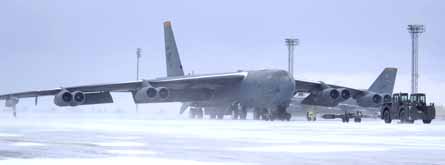Service impressed with results, but will have to look overseas for future test supplies
Synthetic fuel testing by the US Air Force has concluded, with encouraging results in cold temperatures for jet fuel made from natural gas using the Fischer Tropsch process. The tests in a Boeing B-52 bomber used a 50:50 blend of synthetic and conventional JP8 jet fuel, but synfuel for further tests will have to come from overseas as there is no active US production facility.
Following earlier flight tests, cold-weather ground tests were conducted at Minot AFB, North Dakota in temperatures ranging from -22e_SDgrC (-7.6°F) to -11.6°C, and included pneumatic and cartridge engine starts. "The aircraft started as expected, just like it was on JP8," says Bill Harrison, chief of the US Air Force Research Laboratory's fuels branch, with no fuel flow problems detected.
Fuel still in the tanks will be drained for materials testing or auxiliary power-unit tests. Afterburning-engine tests are planned once the USAF orders more fuel. "We are going to get into that, probably in fiscal year 2008, with some preliminary work later this year," Harrison says. The USAF plans to certificate its entire fleet for synthetic fuel by 2010.
|
|---|
The cold-weather B-52 trials have reduced the risks associated with fleet-wide synthetic fuel introduction by 2010 |
The fuel for the B-52 trial was made by Syntroleum, which mothballed its Tulsa, Oklahoma facility after providing 379,000 litres (100,000USgal) at $5.3/litre. "We are hoping to pay a much lower price," says Harrison, noting that potential future suppliers already have commercial-scale operations.
The US Defense Energy Support Center will issue a solicitation soon, Harrison says, with possible suppliers including Chloron of Germany, a Shell plant in Malaysia that makes diesel from natural gas and Sasol of South Africa. Sasol already has a commercial synthetic jet-fuel operation and produces 100,000 barrels of fuel a day, says Renus Kelfkens, the company's US coal-to-liquids country manager. The synthetic fuel is mixed with jet fuel in a 30:70 blend, but is not exported.
Source: Flight International
























